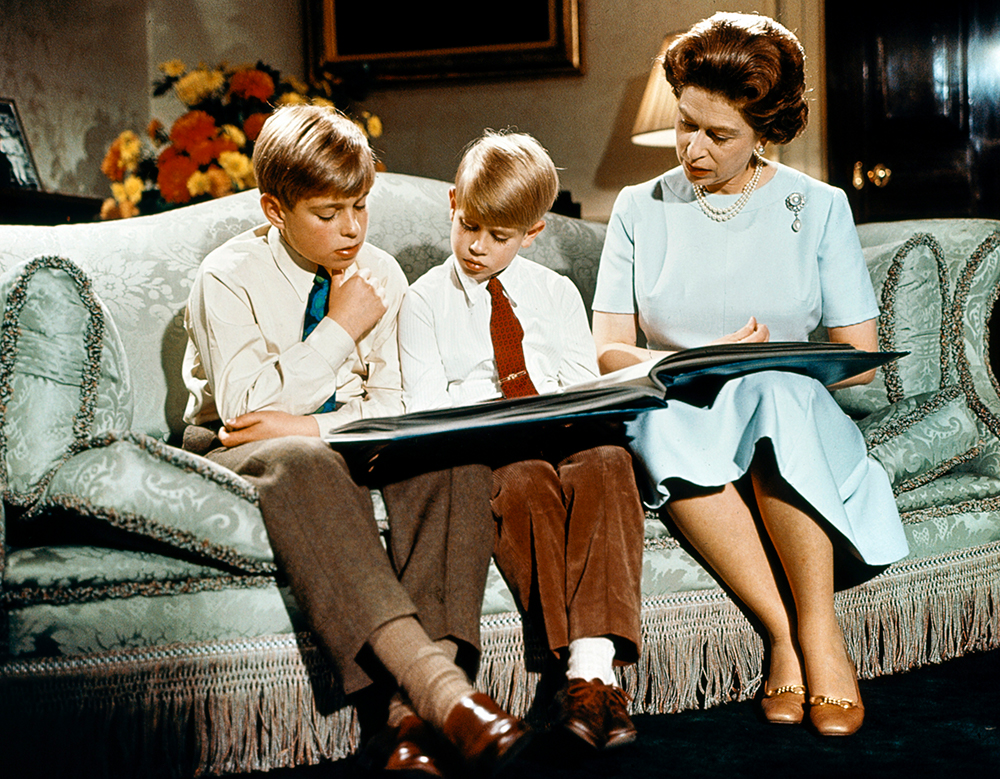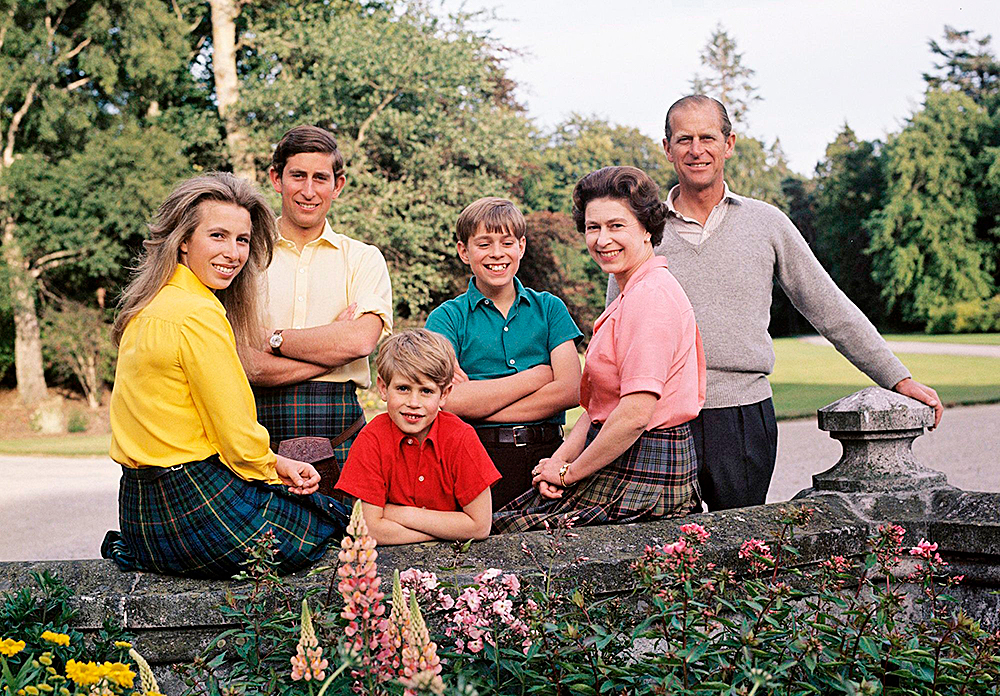In 2012, Kate Winslet was invested by the Queen as a Commander of the Order of the British Empire. During their brief chat, the actress told the monarch that she “loves being a mum”, to which the Queen is said to have replied, somewhat wistfully, “Yes, that’s the only job which matters.”
The Queen effectively had two families, separated by a decade. She also had two attitudes to bringing up her children. Charles and Anne, born in 1948 and 1950 respectively, saw the more formal side of her. By the time Andrew and Edward came along in 1960 and 1964, she had mellowed, just as society’s attitudes had relaxed.
Prince Charles Philip Arthur George was born at Buckingham Palace and, according to a courtier, “Prince Philip just didn’t want to be involved”, staying in his study as his wife gave birth, “which was probably just as well, given that Prince Charles was born by Caesarean section.” When the princess came round from the anaesthetic, he popped into the delivery room with flowers and Champagne. An equerry had thought it appropriate.

Balmoral, 1951: King George, Elizabeth and Philip with little Charles, who’s perched on a statue.
The new parents were absolutely delighted – and deeply in love. In October the next year, Philip was posted second-in-command at HMS Chequers on Malta.
Elizabeth was given the chance to join her husband and live a near-normal life as a young married couple enjoying an overseas posting. The pair left Charles in the hands of his grandparents, King George VI and Queen Elizabeth, and the princess spent her time in Malta mingling with other wives, swimming in the sea and attending teas and parties. It was a brief escape from a life of public duty.
The next August, back in their new home at Clarence House, London, Elizabeth gave birth to her second child, Princess Anne Elizabeth Alice Louise. Charles was three and Anne 18 months old when the King died and their mother became Queen. The responsibilities of Elizabeth’s new, all-encompassing role meant Charles and Anne saw their parents rather infrequently. Shortly after her coronation, the Queen embarked on a six month tour of the Commonwealth from November 1953 to May 1954, during which time the children stayed in England.

The doting parents pose with little Charles and baby Anne in 1950.
Years later, Charles told his biographer Jonathan Dimbleby that it was “inevitably the nursery staff” who showed him how to play, saw his first steps, and disciplined and praised him. But he became very close to his grandmother, Queen Elizabeth the Queen Mother.
“Since I was a child, I adored her,” he said in his eulogy on her death in 2002. It was the Queen Mother who used to visit Charles at his Scottish secondary school, Gordonstoun – which he hated and called “a prison sentence” and “Colditz with kilts” – and stirred his abiding interest in the arts.

Charles with the Queen Mother, whom he adored, and wee dog Pippin.
The Queen did enjoy the rare time she got to spent with her children. Philip’s uncle, Lord Mountbatten, said that the Queen’s best night of the week was “Mabel’s night off” – Mabel being nanny to Charles and Anne. “When nanny Mabel was off duty, Elizabeth could kneel beside the bath, bathe her babies, read to them and put them to bed herself.”
These good nights didn’t come often. “At the beginning, she was learning her job and had too much on her plate to enjoy her children,” said Lord Charteris, her former private secretary.
Princess Anne, tougher and less shy than Charles, grew close to her mother, a keen horse rider, in her teens. Historian Robert Lacey noted, “With her love of horses, Anne developed an especially close relationship with her mother during her teenage years, giving her advice about fashion and clothes.”
Anne swept away any criticism of the Queen’s parenting style in 2012. “I don’t believe any of us for a second thought she didn’t care for us in exactly the same way as any other mother did,” she said.

Anne and Charles are taken to Malta in 1954 to meet their parents, returning on the Royal Yacht after a long tour of the Commonwealth.
But there was a huge difference when Prince Andrew Albert Christian Edward was born in 1960. The Queen had been monarch for eight years and, now confident in her abilities, became warmer – and ready for a second family.
Robert Lacey said, “Her Majesty decided that she had done her duty by her country, and took the best part of 18 months off work to produce and enjoy her ‘second family’.”
The Queen was besotted with her second son. “The baby is adorable,” she wrote to a cousin. “He’s going to be terribly spoilt by all of us, I’m sure.” He was. Elizabeth bathed him and put him to bed every night. As a child, he was allowed to ride his bike up and down the corridors of Buckingham Palace and Windsor Castle – unthinkable a few years earlier.

Elizabeth was besotted with little Andrew. “The baby is adorable. All in all, he’s going to be terribly spoilt by all of us, I’m sure,” she said.
Andrew, too, was sent to Gordonstoun, but he loved it. Learning to operate a glider there led to a career in the Fleet Air Arm, serving in the Falklands War as a helicopter pilot. Despite gaining a reputation for being arrogant, he was said to be her favourite child, but he was the one who would later cause her the most heartache, thanks to his involvement in the Jeffrey Epstein scandal and accusations of sexual assault against a teenage girl.
Prince Edward Antony Richard Louis‘ birth in 1964 showed how far the Queen had come in her thinking – she insisted Philip was present.
Royal writer Ingrid Seward noted in one of her books, “The Queen, by then aged 37, had asked him to be there. She’d been keenly reading women’s magazines that stressed the importance of involving fathers in childbirth and had become fascinated by the idea.”

The Queen poses with three-month-old Prince Edward in 1964. His birth was the first Prince Philip had attended.
Whether Philip was keen on the idea or not, he held his wife’s hand tightly as she gave birth on March 10.
She spent more time with Edward than any of her other children. He’s had a few slips – overestimating his ability in the Marines, botching a royal version of the TV show It’s a Knockout and allowing his TV company to follow Prince William around when he was at university – but has become a solid royal performer.

Andrew (left) and Edward read during the recording of the Queen’s Christmas message in 1971.
His marriage to Sophie, Countess of Wessex, was another bond. “She is like another daughter to Her Majesty, they are that close,” says one courtier.
All families have ups and downs, but the royal family’s take place in public. By the time the Queen passed away, she had eight grandchildren and 12 great-grandchildren. That can be counted as success.

Our three sons: The boys line up with their parents.
In 2018, Robert Lacey wrote about how far the Queen had come in terms of family relationships.
“Elizabeth II enjoys life as a mother, grandmother and great-grandmother. She clearly delights in the time she can spend with her family and she seems to be anything but emotionally reserved.

The family gathers at Clarence House in 2007 to celebrate the Queen and Philip’s forthcoming diamond wedding anniversary.
“Would she have mothered her children differently if she had the chance? As one of her close friends has said, the Queen was rather scared of parenting when she started out – she’d not been taught it by her own mother. But as she grew into the job, her successive children helped remove her fears.”


.jpg)